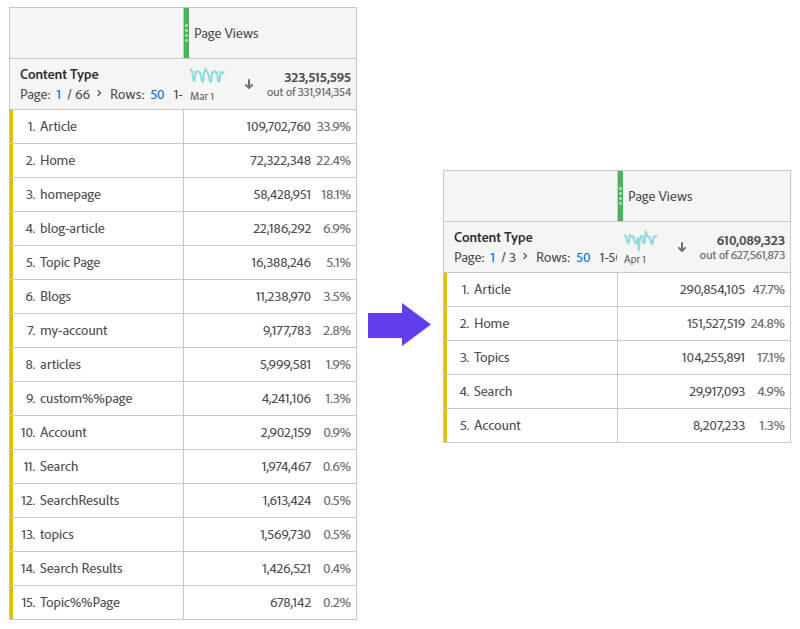Data Renovation Enhances Reporting, Decision-Making, and Cost Savings

Overview
A multi-brand news organization distributes their content across multiple platforms including websites, iOS apps, Android apps, Google Accelerated Mobile Pages (AMP), and Facebook Instant Articles. Their data was captured in Adobe Analytics across dozens of report suites. All of the brands and platforms have the same general structure and content types but weren’t always being tracked in Adobe in a consistent way.

Challenge
The company has been using Adobe Analytics for more than 10 years, and each brand and platform has its own engineering team and dedicated report suite. With the implementation work distributed across so many different groups over such a long period of time, it was difficult to:
- Prevent individual teams from inventing and implementing their own tracking standards
- Monitor and enforce consistent tracking practices
- Update tracking in a timely manner to take advantage of Adobe’s latest new features and functionality
Multi-suite tagging was in place to send data to individual brand/platform report suites, as well as a consolidated global report suite. This increased costs, and the quality of the data in the global report suite suffered due to the misalignment across all the underlying individual report suites.
Despite having a state-of-the-art implementation when they first launched Adobe Analytics, the company’s data quality began to erode over time. They couldn’t analyze data holistically across their brands and platforms, limiting their access to valuable insights and their ability to take action on their data.
Solution
The company partnered with Blast Analytics to assess the current state of tracking on their various websites and mobile apps, and to develop, document, and implement a new globally-aligned standard.
The project began with a series of discovery meetings with key stakeholders to discuss their business objectives, key performance indicators (KPIs), and existing data. After gaining a deep understanding of their business objectives, Blast reviewed the data points collected on each brand and platform to determine its intended purpose and usefulness to the business.
Blast then conducted an Adobe Analytics audit for each website and mobile app to identify conflicts and inconsistencies. Where conflicts existed, Blast and our client worked together to create a new global standard and document it in a Solution Design Document.
Once the global standards were established, Blast developed and provided implementation guides to each brand engineering team. By following the implementation instructions in these guides, each brand would have a clean, structured data layer that was 100% aligned across all brands and platforms.
Previously, each website’s Adobe tracking had to be configured individually in the company’s tag management system due to the inconsistent tracking standards used across brands. Updating and aligning the data layer variables according to a universal standard enabled our client to have a single, global Adobe configuration within the tag manager.
Results
The global tracking standardization and updated implementation will save their engineering teams a considerable amount of development time when implementing future enhancements. It also ensures that data is being collected consistently, leading to improved data quality and decision-making abilities.
As an example of how this data renovation improved our client’s data quality, you can see that the Content Type Report had previously contained unusable data (shown below at left). A single content type might appear on multiple line items due to inconsistent values being used. In other cases, random values were captured that didn’t truly reflect content type. This yielded a report with more than 100 line items that required manual adjustments from analysts to derive insights. After the duplicative/inconsistent content types were standardized and the random values were categorized under more meaningful content types (shown below at right), the report now contains a much shorter list with succinct, clean values.

By aligning all the eVars, props, and events across all report suites, the data captured in the global report suite now contains clean, trustworthy data. Having a reliable global report suite allowed our client to adopt virtual report suites and retire the individual report suites, greatly reducing their monthly server call volume and creating considerable cost savings.
This data renovation exercise improved their data quality and now allows them to combine data that was previously too disjointed to analyze collectively. Rather than spending time cleansing data to make it usable, their analytics team is now empowered to focus their time and energy on finding insights in Adobe Analytics that will drive business improvements.





